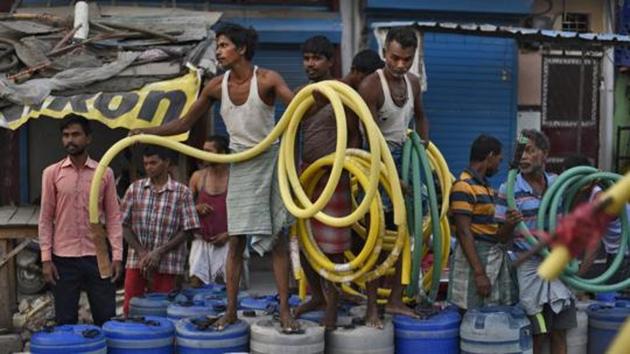Govt draws up list of local bodies facing water crisis
The ministry plans to address this crisis, in part, by launching a people’s movement , and hopes to do this by the end of November in the most water stressed parts of the country.
The cities of Patna, Chandigarh, Delhi, Pune, Indore, Nashik, Ludhiana, Jaipur, Jodhpur, Kota, Agra, Ghaziabad, and Hyderabad are among those that face a severe water crisis, according to a study by the ministry of housing and urban affairs.

The ministry plans to address this crisis, in part, by launching a people’s movement , and hopes to do this by the end of November in the most water stressed parts of the country. This year, Chennai and Bengaluru have witnessed a significant water crisis, highlighting the vulnerability of large metropolises to water shortage.
In all, according to the ministry, 255 districts (India has a total of 725 districts), 756 urban local bodies (ULBs; municipalities and corporations), and 1,597 blocks across the country face a severe water crisis and shortage of drinking water from a rapid decline in ground water levels due to indiscriminate extraction, erratic monsoons, and unauthorised development.
The ministry of housing and urban affairs has prepared guidelines for urban water conversation which will be implemented in two phases in collaboration with the ministry of Jal Shakti’s flagship scheme, Jal Shakti Abhiyaan. In the first phase, 496 ULBs have been identified in 200 districts (the work here will happen between July 1 and September 15). In the second phase, between October 1 and November 30, the guidelines will be implemented in 260 ULBs in 55 districts.
According to government think-tank NITI Aayog, India is facing water crisis with around 50% population experiencing high-to-extreme water shortage.
“In order to address water scarcity, it is important to undertake efforts for conservation, restoration, recharge and reuse of water. In this pursuit, Ministry of Housing and Urban Affairs (MoHUA) is participating actively in the Jal Shakti Abhiyan along with states and union territories and Urban Local Bodies ,” an official working closely with the project at the ministry of urban affairs said on condition of anonymity. The Jal Shakti Abhiyan is India’s newly launched water mission.
The ministry has identified four main areas under the programme: Rain Water Harvesting (RWH), reuse of treated waste water, rejuvenation of water bodies, and plantation.
“The crux of this drive is building large scale awareness campaign so that conservation of water becomes a Jan Andolan (popular movement),” the official added.
The most affected districts identified by the Centre lie in Uttar Pradesh (35) with 84 ULBs followed by Rajasthan (29) with 111 ULBs and Telangana (24) with 29 ULBs. These areas have been identified as the most water stressed ULBs and will be covered in the first phase.
The second phase has water stressed ULBs affected by returning monsoon with the most districts being in Tamil Nadu (27), Karnataka (18) and Andhra Pradesh (9).
The ministry has asked ULBs to engage with Resident Welfare Associations, schools, businesses, Civil Society Organizations (CSOs), Nehru Yuva Kendras (NYKs), NSS volunteers, NCC cadets and others to organize a door- to-door outreach, community events and workshops for dissemination and building awareness for all four enlisted water conservation measures in urban areas.
The ministry has also asked ULBs to enforce building by-laws as per the provisions of the model building by-laws (MBBL) 2016 to ensure that the rain water harvesting provisions are incorporated. And it wants them to also monitor this closely.
The ministry has proposed the creation of a Rain Water Harvesting Cell which will be responsible for effective monitoring of Rain Water Harvesting in the city. It will also monitor the extent of ground water extraction and ground water aquifer recharge.
The National Urban Sanitation Policy 2008 mandates reuse of at least 20% of treated waste water. “ In all new government buildings/Group Housing Societies, public buildings, whenever building plan is approved, it should be ensured that there should be dual piping as has been provided in City/State/UT BBLs, “ the guidelines state.
The ministry of urban affairs is tasked with providing water supply and sewerage under the Atal Mission for Rejuvenation and Urban Transformation (AMRUT). The key aim of the scheme is to ensure that every household has access to a tap with the assured supply of water and a sewerage connection.
“AMRUT guidelines allow funding for rejuvenation of water bodies in AMRUT cities. ULBs should undertake rejuvenation of at least one water body in their jurisdiction, availing the funds under AMRUT,” the ministry’s guidlines for funding the programme state.
In cities not covered under AMRUT, ULBs should utilise state funds, grants available under 14th Finance Commission or State Finance Commission, explore financing through Corporate Social Responsibility funds of companies, even monetise some of their land holdings, the ministry has suggested.
“To implement something effectively, the best source through which you can go are Urban Local Bodies because it is in their direct mandate to implement all this and it is a good decision to do so. But at the same time, urban development including water management at local level is a state subject, it has to be adopted by the state government and then passed on to the ULBs for it to be effectively implemented. The procedural change needs to be established otherwise it is good move and the right way to implement water conservation,” said KT Ravindran, professor and head of urban design at the School of Planning and Architecture of New Delhi.






